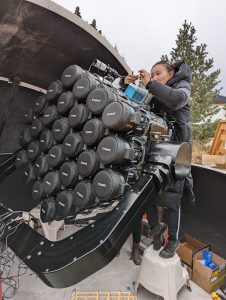main content begins

Grad student Seery Chen connects cables to a power supply on the Dragonfly telescope in New Mexico, in November of 2022. Credit: Seery Chen.
In 2022, the Dragonfly team completed 70 per cent of its ultrawide survey, which will map out the full footprint of sloan digital sky Survey when complete.
An expansion of an additional 120 lenses is currently underway in 2023.
According to Cold Dark Matter (CDM) cosmology, structure in the Universe grows from the “bottom up”, with small galaxies merging to form larger ones. Evidence of such mergers can be seen in faint streams and filaments visible around the Milky Way Galaxy and the nearby M31 galaxy.
But the CDM model predicts that we should see more of this structure than is currently observed. However, images obtained using even the largest, most advanced telescopes today contain scattered light that may be hiding this faint structure. Dragonfly is designed to reveal the faint structure by greatly reducing scattered light and internal reflections within its optics. It achieves this using commercially-available Canon 400mm lenses, with unprecedented nano-fabricated coatings with sub-wavelength structure on optical glasses.
Also, Dragonfly images a galaxy through multiple lenses simultaneously—akin to a dragonfly’s compound eye—enabling further removal of unwanted light. The result is an image in which extremely faint galaxy structure is visible.
The co-principal-investigators for Dragonfly are U of T’s Professor Roberto Abraham and Yale University’s Professor Pieter van Dokkum.